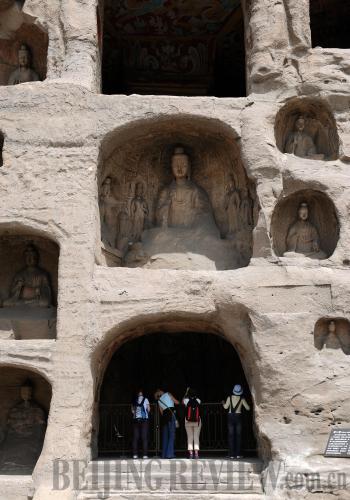|
 |
|
NEW LOOK: All institutions and commercial operations considered by experts harmful to the protection of the Yungang Grottoes in Datong, Shanxi Province, have been removed from the core scenic area (XINHUA) |
Since the first batch of cultural and natural sites of China were inscribed on the UNESCO world heritage list in 1987, China now has 40 listed sites, ranking third in the world in terms of the number of listed sites.
Though none of China's world heritages have been listed as an endangered site, or any face the danger of being excluded, there is still a great deal that could be done for China to improve its heritage preservation, said Guan Qiang, Director of the Department of Cultural Relics Protection and Archaeology of State Administration of Cultural Heritage (SACH), at a meeting in Beijing on world heritage monitoring work held on May 19-20 this year.
At the meeting, delegates from world heritage sites, such as the Mogao Caves in Dunhuang, Gansu Province, the classical gardens of Suzhou, Jiangsu Province, the Summer Palace and the Peking Man Site at Zhoukoudian in Beijing, reported on monitoring and protection work.
Monitoring system
 |
|
TOURISM BOOM: As more and more visitors pour into Lijiang, Yunnan Province, the ancient town in southwest China has drawn attention of the world because of how it balances the relationship between economic development and heritage protection (XINHUA) | The reporting mechanism on monitoring work is a measure taken in response to a system launched by the World Heritage Committee in 1994. It includes regular inspection, discussion and assessment of the state of preservation of world heritage sites and carrying out reactive monitoring.
In 2006, the Chinese Ministry of Culture set down Measures for Protection and Management of World Cultural Heritages. Since then, the country has established a monitoring system to protect heritage sites in China. If a site's value, authenticity and integrity are threatened because of inadequate protection, it is added to a warning list released by the SACH. In December 2006, the SACH promulgated measures to monitor and manage China's world cultural heritage sites—specifying procedures, responsibilities and range—to standardize the monitoring work.
During the 31st session of the World Heritage Committee in 2007, the ancient town of Lijiang, Yunnan Province, received inquiries from the World Heritage Committee about whether the city would be capable of balancing protection and social development or even overdevelopment.
Economic concern
Lijiang was listed as a world cultural heritage in 1997 and has since become well-known to the world. Within 10 years, the population of people of the Naxi ethnic group living in Lijiang decreased to a few thousand from 40,000. Most aboriginal residents moved out of the ancient town, replaced by tens of thousands of tourists. Many shopkeepers on commercial streets now have non-local accents. In the evening, red lanterns and bars full of people made visitors feel as if they are in a bustling city.
The city's situation is not a single case in China. A lot of new construction aimed at promoting regional economic development has caused overheated commercialization of some of China's world heritage sites. New buildings or facilities—such as hotels, restaurants and cable cars—close to the sites, have severely damaged the integrity of the heritage.
What is heartening is China has now established a monitoring system featuring a three-level structure—state, provincial and local. The SACH in particular has put increasing efforts in carrying out active and reactive monitoring work.
The monitoring work on the Yungang Grottoes in Datong, Shanxi Province, inscribed to be a world heritage site in 2001, is an example.
As the heritage site had been suffering from air pollution, acid rain, coal dust and the pouring of tourists for long time, the local government took some measures to improve the environment near the site.
In 2009, the government of Datong spent 560 million yuan ($82.4 million) on a comprehensive renovation and reconstruction of the site's surrounding areas. But the artificial lake, the ancient-style streets, roads and the square in front of the Grottoes along with other projects were within the preservation range of the site and construction control zone, which is prohibited to have new constructions by the Central Government. These new constructions caused great harm to the authenticity of the heritage.
Noticing this, the SACH has sent several investigative missions to Datong and consulted experts on historical relics about preservation, and finally solved the problem.
"More than half of China's world heritage sites are located in scenic spots. Tourist development is inevitable. In the past, economic interest has been the most direct and most obvious change brought by the success of world heritage applications. But now the success of applications has become a restriction, and the idea of sustainable development is the priority, replacing quick, profit-oriented development," said Zheng Bingxiu, Deputy Director of Wutai Mountain Scenic Area Administration Bureau.
The Wutai Mountain was listed as a world heritage in June 2009. In line with an overall preservation plan, reconstruction was carried out at the outer ring of the core area. Meanwhile the administration bureau also established a monitoring system in the core area of the site in accordance with relevant requirements, proceeding with monitoring of indexes such as tourist capacity and atmospheric pollution.
"Now a world heritage listing has become more of a responsibility than purely glorious," said Zheng.
| 